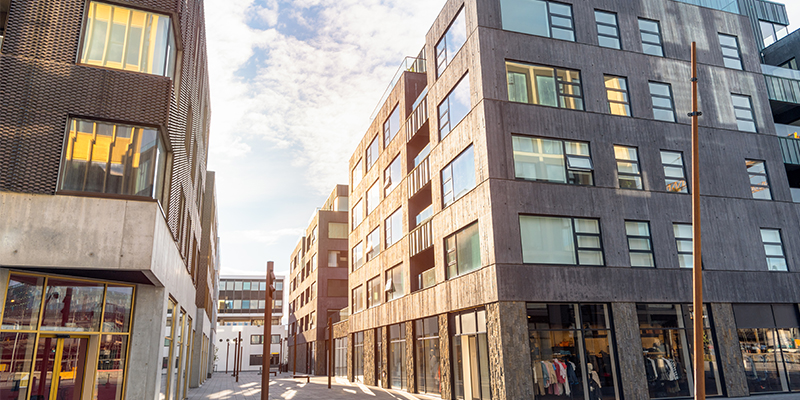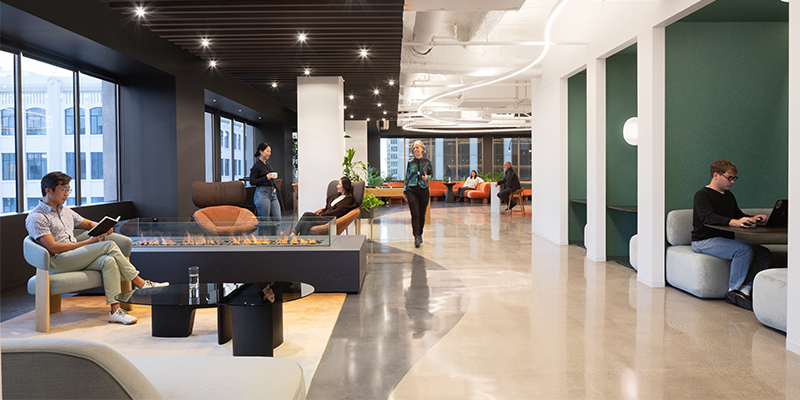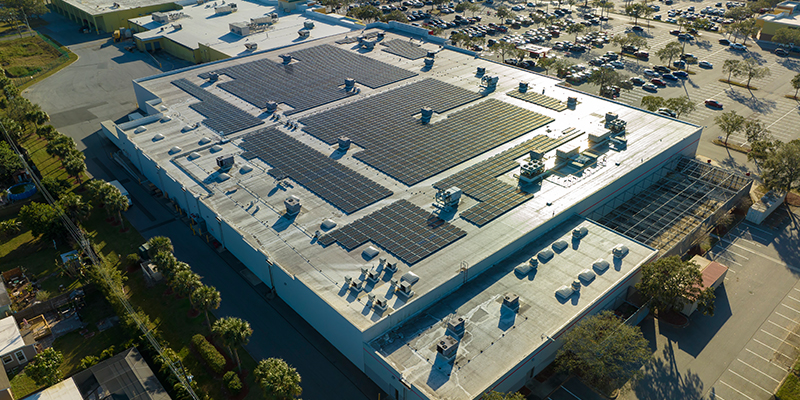America faces a multipronged real estate crisis. We have a stubborn residential housing shortage, high office vacancy rates, and flight from many downtown hubs that is killing off businesses servicing those areas. In West Coast cities like San Francisco, it’s been dubbed the “donut effect,” with workers moving farther away from the urban core.
We need to build 3.8 million more housing units in the United States to keep up with household formation rates – and we’re very behind. Construction rates need to double from now to 2030 to bring us up to speed. Climate change only raises the stakes: to stave off the worst-case climate scenario and double construction output in the next seven years, we need to slash per-project emissions by at least 70%.
Converting office towers into housing could solve multiple problems at once: increase available housing; revitalize downtowns and their property tax base; all while attracting populations to city centers where green living is easier.
Right now, the office-conversions conversation focuses on the benefits of providing affordable housing. However, office conversions are also a huge opportunity to fight climate change. Incentivizing more people to move into downtown converted offices reduces carbon in two significant ways. First, it avoids the carbon emissions of building a new structure. Second, it reduces the transportation emissions for those downtown residents compared to residents outside the city center.
Like most carbon problems, attaching a dollar number to this societal benefit takes work. If we were to extrapolate New York Local Law 97’s newer carbon pricing as well as the federal electric vehicle (EV) tax credit, the carbon-to-dollars conversion becomes straightforward and yields an additional benefit of up to $25 per square foot. This post explains our calculations behind that figure.
Adding the carbon benefit to the affordable-housing benefit provides the political rationale for government bodies (whether local, regional, state or federal) to provide a hard subsidy to developers. This subsidy would tip the scales to make office conversions financially feasible – and go a long way towards solving all the problems above.
Why converting offices to housing is financially challenging today
Broadly speaking, conversions are 30% cheaper than building new, but developers can’t earn the same square-foot revenue for a residential conversion as they could for building new. A developer can build a new residential building for $325 to $375 per square foot, according to Eddie La Berge, business development manager at Turner Construction Co and immediate past president of NAIOP Oregon. If it costs $225 or more per square foot to renovate a Class C building – one that badly needs upgrading and no longer commands a good office rent – the developer has to buy the building for less than $100 per square foot for the math to work.
Converting from office to residential also means developers contend with residential development fees and a lot of red tape, both of which eat up that 30% conversion savings.
But this math ignores a big, important benefit: these old buildings are already sequestering carbon just by staying in existence. Converting an old building is much more carbon-efficient than knocking it down or constructing a new building.
How developers can price in carbon avoidance more appropriately to make office conversion math work
Pricing carbon is tricky. But New York’s Local Law 97 and the Inflation Reduction Act both place carbon’s price much, much higher than it’s ever been. Developers should be arguing harder to get the value of carbon avoidance priced accurately and factored into their profit and loss statements (P&Ls) as tax rebates and other incentives.
Let’s start with the carbon avoidance of saving an older building. According to EPIC[1], the carbon saved by retaining an existing building – what’s known as “embodied carbon” – equals about 45 kilograms of carbon emissions (kgCO2e) per square foot. Using New York’s new carbon penalty of $268 per metric ton of carbon emissions (mCO2e), the carbon-to-dollar conversion yields about $13 per square foot. For the step-by-step math behind this figure, click here.
Now let’s consider the carbon savings related to transportation of a resident moving downtown. The Inflation Reduction Act gives consumers who buy a new EV a $7,500 tax rebate – that is, in effect, paying people to avoid future carbon emissions related to transportation. If the government is willing to pay car drivers $7,500 to buy a new EV, we’d argue that attracting populations to live in cities – where they drive much less and avoid much more carbon emissions – should be equally incentivized. For people to move into downtown areas, however, appropriate housing must exist in good supply. Developers are in a unique position to provide that housing via office conversions.
We think the environmental impact is so substantial, it’s logical for cities to offer developers another tax credit for office conversions that developers can deduct from their cost.
This figure translates to an additional $12 per square foot in carbon avoidance savings. Again, we share our math here.
If you add together these two figures – $13 per square foot for embodied carbon saved and $12 per square foot for transportation carbon saved – you’ll get a total carbon avoidance savings for office conversions of $25 per square foot. That’s equal to about 10% of the conversion cost. That might sound minor, but it’s enough to make the developer math on office conversions work.
If this all sounds pie-in-the-sky, know that developers are already succeeding with this strategy. Real-world examples, like the Arlington project cited in this Development magazine article, prove developers can argue for carbon avoidance valued in hard dollars and win.
What’s more, the $25 per square foot benefit only reflects the value of carbon savings. When you consider other benefits like increased affordable housing, economic revitalization and increased land value of surrounding buildings, the societal benefit is much higher than just $25. Besides New York, other leading North American cities are recognizing this and acting quickly. In Canada, the City of Calgary is incentivizing developers with grants of $75 per square foot for office-to-residential conversions. Vancouver is paying developers hard cash to reward embodied carbon reduction. This is only the start.
Creating the right environment for revitalization
Market forces and incentives can go a long way to creating the right environment for office revitalization. NAIOP has been at the forefront of advocating for adaptive reuse incentives at the federal level. As the association states, “Repurposing of existing underutilized structures is environmentally sustainable compared to demolition. Extending the use of an existing building, to increase the housing supply or for other socially beneficial purposes, is a better economic alternative that also results in reduced environmental impact, including greenhouse gas emissions.”
Office conversions are a win-win-win for residents, developers, and the cities who want to revitalize their cores and meet climate targets at the same time. Isn’t this the time for regulators to act?
$13 per square foot in carbon avoidance savings for office conversions:
A brand-new multifamily residential building generates about 49 kilograms of carbon emissions (kgCO2e) per square foot, just in the structure or embodied carbon emissions. By reusing existing structures, we can save the majority of these emissions and could credit that back to the developer.
By applying the cost of carbon as defined by NYC’s Local Law 97 ($268 per metric ton as the penalty for not meeting the new lower-carbon building thresholds), that’s about $13 per square foot, worth about $650,000 for a 50,000-square-foot apartment.
$12 per square foot, as derived from the IRA’s electric vehicle tax rebate:
The IRA gives consumers a $7,500 tax rebate for buying a new EV. Imagine we were to apply the value of a $7,500 EV rebate directly to a 500-square-foot apartment downtown, which we need to gross up to 600 square feet to include common areas. That would divide $7,500 by 600 = $12 per square foot.
Some might argue that this $12 per square foot should be payable to residential tenants, not developers, as an incentive to get them to move to greener cities. We think it should be payable to developers because developers sit at the top of the housing supply funnel. Tenants cannot choose to move into sustainable city housing unless it exists in ample supply – which it does not currently. Converted, sustainable housing won’t become more widely available to tenants without modest but significant developer incentives like this one.
[1] Rusk, J., Yu, L., Jacobson, B. (2023). Early Phase Integrated Carbon (EPIC) Assessment. EHDD Architecture. San Francisco, CA. Accessed 04/04/2023.
Content and strategies shared in NAIOP blog posts are intended to provide information and insights to industry practitioners and do not constitute advice, recommendations, or the opinion of NAIOP. NAIOP disclaims any liability for actions taken as a result of these blog posts.








